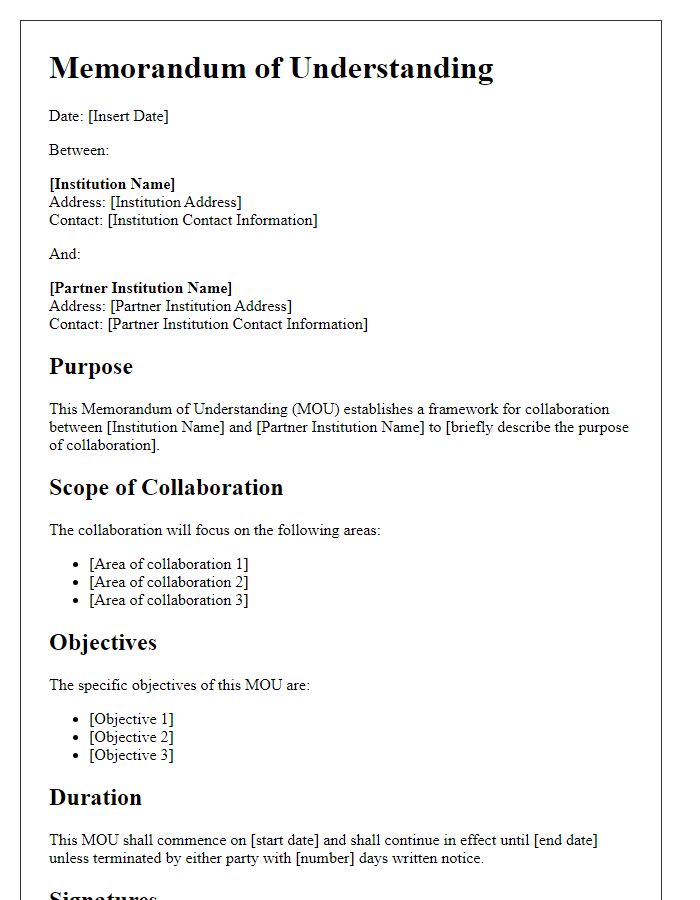Are you looking to forge meaningful partnerships that drive innovation and progress? Crafting a robust institutional collaboration agreement can set the foundation for shared goals and mutual growth. In this article, we'll guide you through the essential elements of creating an effective template that ensures clarity and alignment between institutions. Join us as we explore the key components and best practices for establishing fruitful collaborations!

Clear Objectives and Goals
Establishing clear objectives and goals in an institutional collaboration agreement fosters mutual understanding and coordinated efforts among partners. Identifying specific targets can enhance outcomes in academic partnerships, such as joint research initiatives or exchange programs. Defining measurable success indicators, like publishing peer-reviewed articles or organizing conferences, can provide tangible benchmarks for collaboration. Furthermore, aligning resources, including funding sources or technological tools from involved institutions, ensures efficient use of assets. Regular review meetings can facilitate tracking progress, maintaining engagement, and addressing challenges. Ultimately, a well-structured framework leads to effective collaborative outcomes, benefiting both entities involved in the agreement.
Roles and Responsibilities
An institutional collaboration agreement outlines specific roles and responsibilities for partners involved in a joint project or initiative. Each institution, such as universities or research centers, may bring unique expertise and resources to the table. For example, in a collaboration focusing on climate change research, one institution may lead data collection efforts in a specific region, while another institution provides analytical tools and methodologies for data interpretation. Detailed definitions of each party's contributions, such as funding amounts, personnel assignments, and project milestones, ensure accountability. Regular progress assessments at designated intervals enhance transparency, allowing for adjustments to roles when necessary. Clear communication protocols facilitate efficient sharing of information among collaborators, which is crucial for fostering a productive working relationship.
Intellectual Property Rights
The Institutional Collaboration Agreement safeguarding Intellectual Property Rights (IPR) outlines the ownership, management, and protection of innovations and creations developed during cooperative research projects between institutions. Involving entities such as universities, government agencies, and private companies primarily focuses on technologies developed through joint funding, creating standards for patent filing (patents filed through the United States Patent and Trademark Office), licensing agreements, and revenue sharing. Clear definitions of background IP (existing intellectual property) and foreground IP (intellectual property generated through collaboration) establish boundaries for usage rights while maintaining confidentiality clauses to protect sensitive information. Additionally, dispute resolution mechanisms are crucial, detailing processes for addressing conflicts related to IPR disputes, thereby fostering a harmonious collaborative environment.
Confidentiality and Data Protection
Confidentiality and data protection are critical aspects of institutional collaboration agreements. Such agreements typically outline the responsibilities of each party in safeguarding sensitive information shared during the course of their collaboration. Key elements may include the definition of confidential information, which often encompasses proprietary data, research findings, and business strategies relevant to the entities involved. Specific clauses may address the handling, storage, and destruction of sensitive data, specifying compliance with regulations such as the General Data Protection Regulation (GDPR) in the European Union or the Health Insurance Portability and Accountability Act (HIPAA) in the United States. Institutions must establish clear protocols for data access and sharing, often designating authorized personnel and limiting exposure to only those who require it for the collaboration. Additionally, the agreement may include provisions for breach notification procedures, ensuring that all parties understand their obligations in the event of a data compromise. Regular audits and reviews can help maintain adherence to these protocols, fostering a secure environment for collaboration.
Dispute Resolution Mechanisms
Dispute resolution mechanisms in institutional collaboration agreements, such as those between universities or research organizations, typically outline processes for managing disagreements. Arbitration clauses, specifying mediation processes and timelines, ensure timely resolutions. Geographic designations, such as New York or London, may dictate legal jurisdiction. Additionally, identifying governing laws, like the United Nations Commission on International Trade Law (UNCITRAL) rules, provides clarity. Important structures include formal dispute resolution boards, which consist of appointed members with subject-matter expertise. Such frameworks promote collaboration, minimize disruptions, and foster a focus on shared goals while mitigating potential conflicts.
Letter Template For Institutional Collaboration Agreement Samples
Letter template of memorandum of understanding for institutional collaboration













Comments